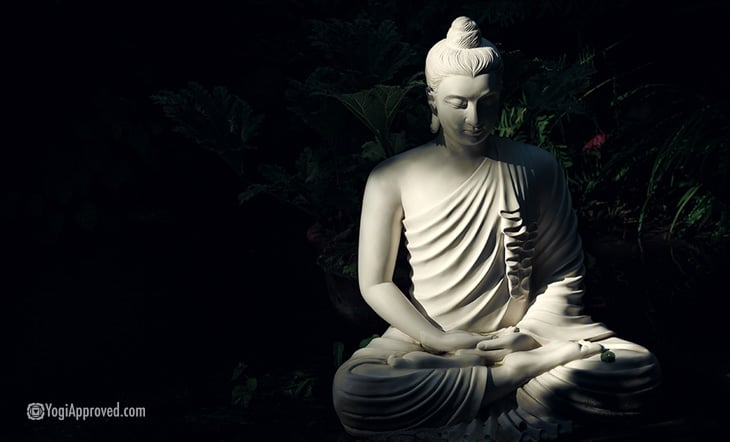How the Buddhist Concept of Dharma Can End All Your Suffering

Dharma featured
Dharma is a Sanskrit word that stems from the verbal root dhri, meaning “to hold” or “to maintain.” But what is dharma, exactly?
With over ten different meanings, as well as varying interpretations from different religions and teachings, the exact definition can be difficult to translate.
However, dharma is commonly known as the Buddhist teaching used to improve quality of life and to help one discover their life’s purpose on their path to enlightenment.
Where Does Dharma Come From?
The concept of dharma, or the “eternal spiritual path,” originates from Hinduism. The idea first appeared in India nearly 4,000 years ago.
In the 18th century, the British East India Company began to study the ancient law books of Hinduism (known as the Dharmashastras). From these sacred texts they translated the word dharma to mean “law.”
The more beings who accept their dharma, the more harmony there will be.
Later in the 19th and 20th centuries, Buddhism adopted this concept of dharma. Before reaching his own enlightenment, the Buddha began to speak of the knowledge he received from dharma to others. After enlightenment, he shared sermons with the hope of helping others find their own “right” path toward enlightenment.
His first sermon was called “Turning the Wheel of the Dharma.” He preached this sermon about suffering and how to find your way out of it just outside the city of Varanasi, India.
A Deeper Look at This Buddhist Concept
In Buddhism, dharma essentially means following the teachings of the Buddha by acting in your own “right way” and doing what is true to yourself. The more beings who accept their dharma, the more harmony there will be.
Living your dharma means doing the greatest good at all times and embracing the essence of who you are. In knowing and following your dharma, you will discover your life’s purpose.
For more help on discovering your life path, check out: How to Listen to Your Dharma and Find Your True Life Purpose
The Buddha Described 2 Ways to Realize Your Dharma:
1. Accept the Four Noble Truths
To live your dharma means to understand the Four Noble Truths. These are:
- The Truth of Suffering: Identifies the presence of suffering
- The Truth of the Cause of Suffering: Identifies the causes of suffering
- The Truth of the End of Suffering: States all suffering will end through enlightenment
- The Truth of the Path Leads to the End of Suffering: States that following the Noble Eightfold Path will lead to the end of suffering
2. Follow the Noble Eightfold Path
The Buddha said that by following this noble path, it will lead to the end of suffering. The steps in the Noble Eightfold Path are as follows:
- Right Understanding
- Right Thought
- Right Speech
- Right Action
- Right Livelihood
- Right Effort
- Right Mindfulness
- Right Concentration
Here’s How to Apply Dharma to Your Life
Now that we’ve learned what dharma is, let’s learn how to apply it! To live by the way of dharma means to live according to what is right – specifically, what is right for you. It is understanding all of the aspects of life that serve you to achieve your highest self. In successfully applying dharma to your life, you will become your most prolific self.
The best way to begin to live your dharma is to simply listen to your intuition. By doing so, you can easily decipher what ideas, people, relationships, duties, etc. serve you on your path to uncovering your life’s purpose.
Use These 2 Rules to Follow Your Dharma:
Along with understanding what dharma is, we need to know how to follow our dharma. Use the following two rules to help listen to your intuition and follow your dharma, and see how much easier your decisions become.
1. The “Feelings Are Greater Than Thoughts” Rule
This rule states that your feelings provide a more accurate representation of how you truly stand on any given matter than your thoughts do.
Thoughts can be overanalyzed, illogical, and – often – not even your own! Feelings, on the other hand, while not “facts,” represent your instinctual stance. Feelings are wholly your own and serve as your personal guiding light to help you understand what is right for you.
Thoughts can be overanalyzed, illogical, and – often – not even your own!
For example, when it comes to making a big decision, many people resort to making a list of pros and cons. While extremely beneficial for outlining facts and organizing your thoughts, you can often find yourself just as indecisive as when you first started.
Instead, physically envision each scenario taking place. Focus on how each outcome makes you feel. More often than not, your intuition ends up easily making the decision for you!
2. The “Heavy Versus Light” Rule
This dharmic rule states that a scenario or opportunity at hand will give you the sense of feeling physically “heavy” or “light.” When it comes time to make a decision, weigh your options based on how each specific option affects your vibe.
For example, “heavy feelings” may come from things such as: accepting a job which doesn’t suit you, lying to your loved ones, or remaining in a location that makes you unhappy.
This all-too-familiar, uneasy feeling of being weighed down in these situations is no coincidence. It is so, because living and acting in these ways goes against your true to self – against who you are.
Trust in yourself and believe in your instincts for they will guide you to your awakening and your happiness.
“Light feelings,” however, may come from things such as: volunteering time in your community, getting out of a toxic relationship, or starting a family.
These are all examples of scenarios that may provide you with an unexplainable sense of joy and ease, leaving you feeling “weightless.” This is so, because you have chosen to do the right thing according to who you are.
For further guidance on finding your life’s purpose, Use These 7 Simple Steps to Create a Fulfilling Life of Purpose
The Takeaway
Following your dharma is achieving your soul’s life purpose by acting in accordance with who you truly are. While this discovery won’t happen overnight, part of the beauty of this journey is learning things about yourself every step of the way.
Trust in yourself and believe in your instincts for they will guide you to your awakening and your happiness. All of the good you do will always make its way back to you. For with good dharma, comes good karma. But, that is a topic for another day. 😉


This Month's Letter
From the Editor
Monthly motivation and food for
thought from our founder.






























